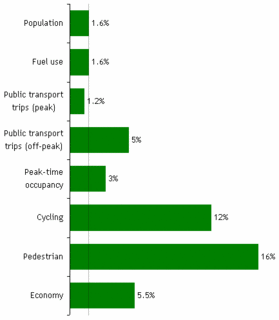On the right track?
Today's Dominion Post contains a couple of articles that are encouraging news for those of us who look forward to a sustainable future for Wellington. The first article was titled Capital drivers heeding message, and referred to a press release from the Greater Wellington Regional Council showing that public transport numbers have increased in the last year and that our fuel consumption is increasing more slowly than in Auckland and Canterbury.
 This is encouraging, but does it tell the whole story? For that, you need to read the full report (940kB PDF) and compare it with some other important data. Yes, the Wellington Region's public transport patronage has increased, but so has the population (by about 1.6% in 2004-05). Our fuel use is actually commensurate with our population increase, and peak-time transit ridership didn't quite keep pace (at 1.2%). The big public transport surge has been off-peak, with 5% more trips: this is great, because it shows that people are starting to see it as useful for leisure and shopping as well as commuting. Maybe the operators will start to put on more off-peak services now!
This is encouraging, but does it tell the whole story? For that, you need to read the full report (940kB PDF) and compare it with some other important data. Yes, the Wellington Region's public transport patronage has increased, but so has the population (by about 1.6% in 2004-05). Our fuel use is actually commensurate with our population increase, and peak-time transit ridership didn't quite keep pace (at 1.2%). The big public transport surge has been off-peak, with 5% more trips: this is great, because it shows that people are starting to see it as useful for leisure and shopping as well as commuting. Maybe the operators will start to put on more off-peak services now!If peak-time ridership decreased per person, but fuel use stayed static, how are people getting to work? Peak-time vehicle occupancy increased from 1.36 to 1.4, which is still pitifully low, but might have made a dent in fuel use. Cycling and walking are a small part of the whole picture, and not really practical for long commutes, but these so-called "active modes" saw a large increase in the last year.
Overall, it's encouraging that people are choosing more sustainable modes of travel. Our per capita fuel use stayed the same, which can be seen as a small victory, as new population growth often occurs on the fringes which require longer commutes and often have poor public transport access. So, did this occur at the expense of economic growth? Far from it: our region's GDP grew by 5.5% during this time, faster than Auckland, Christchurch or the country as a whole.
But to really make a dent in car use there needs to be a real improvement in public transport, which is where the second story comes in. It's about the new Metlink brand which is set to integrate the signage and timetabling of train and bus services. It might seem just cosmetic, but if it makes things a bit easier then it could help.
Improved information (such as timetables, routemaps and the txtBUS service) can certainly make it easier to use and get started with the public transport network, so that's a good start. However, it's going to take some bigger changes, both carrots (faster, cheaper, cleaner, more reliable, more frequent services) and sticks (high-occupancy lanes, congestion charges, reduced parking) to really make a difference. Wellington has the best chance in the country to have a truly sustainable transport network (linear rather than sprawling geography, compact CBD, twice the per capita public transport use of any other city): we just need the investment and the political vision to make it happen.



2 Comments:
I'd have thought the enormous government commitment to Wellington public transport funding including transport demand management showed that this was well on the way - $225 million of Crown funding over ten years announced in January and another $255 million for the Western Corridor (excluding the coastal highway). Yes some of that is for roads, but it does effectively provide for new trains, upgraded stations, rebuilt trolley buses, more PT priority systems, realtime information systems.
In other words, all of the sensible public transport that could be funded in Wellington in the next decade - will be! The key is to make sure it doesn't take people from walking and cycling, which is the experience in many other places - e.g. Perth, Christchurch.
You could call the government commitment "enormous", but it pales in comparison to the cost of new roads that some the roading lobby is calling for.
There's a lot more that can be done, including the "carrots and sticks" that I mentioned in my post as well as encouraging transit-oriented development along rail lines and curbing sprawl in the northern suburbs and Kapiti. You may not think of those as "sensible", but I do.
And by the way, I wouldn't have thought that improving transit to the Hutt Valley and Johnsonville is likely to take people from walking or cycling.
Post a Comment
<< Home